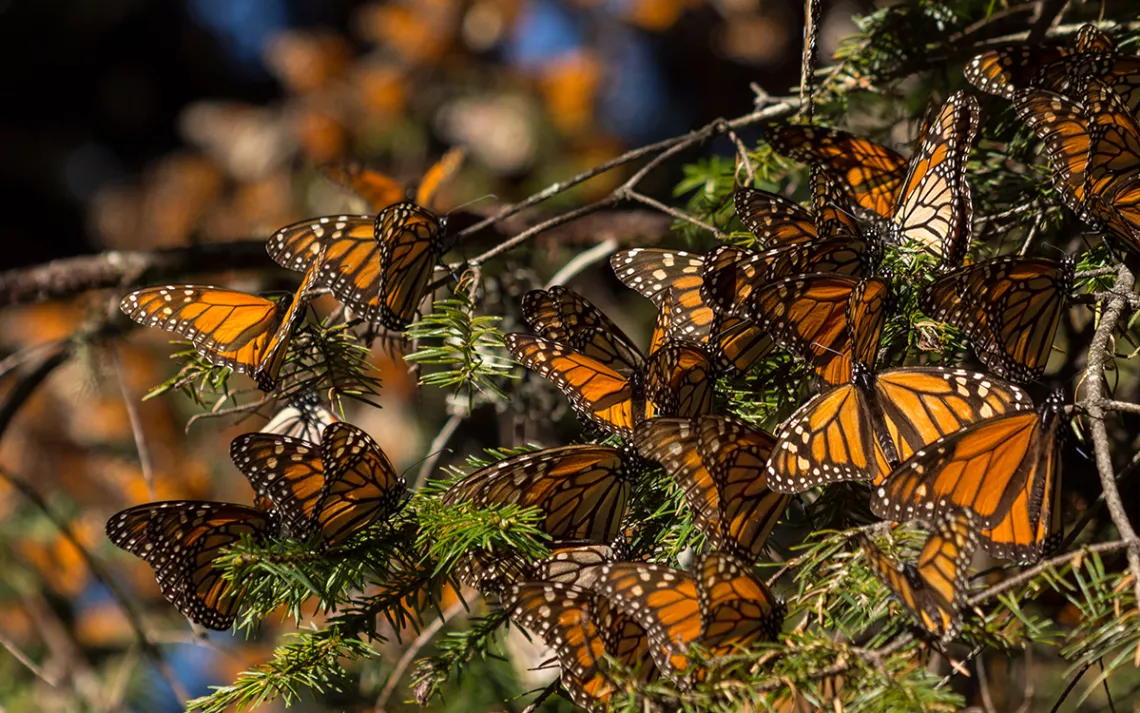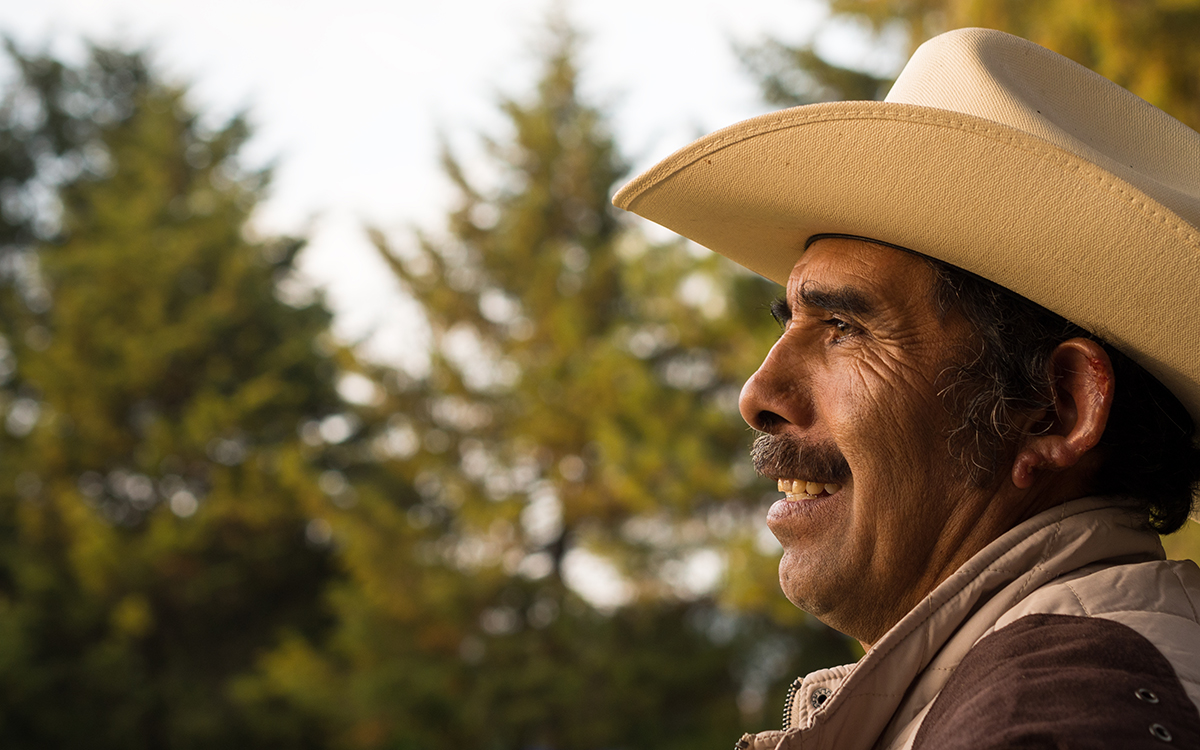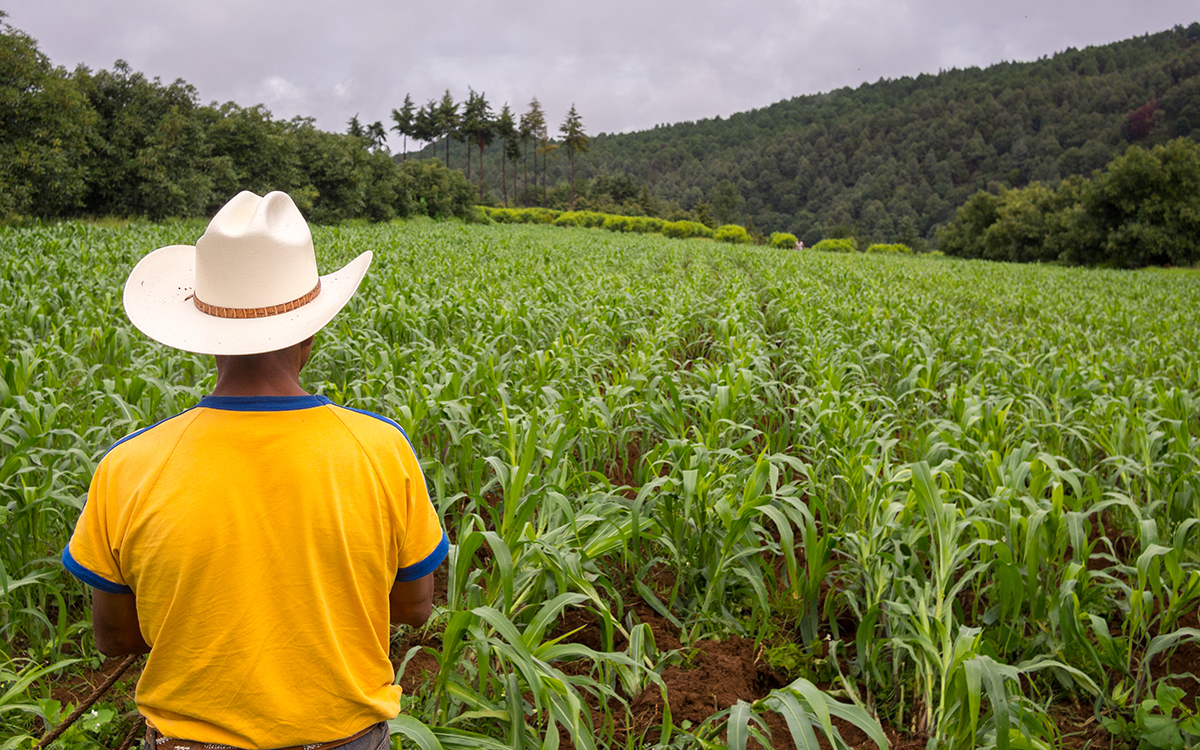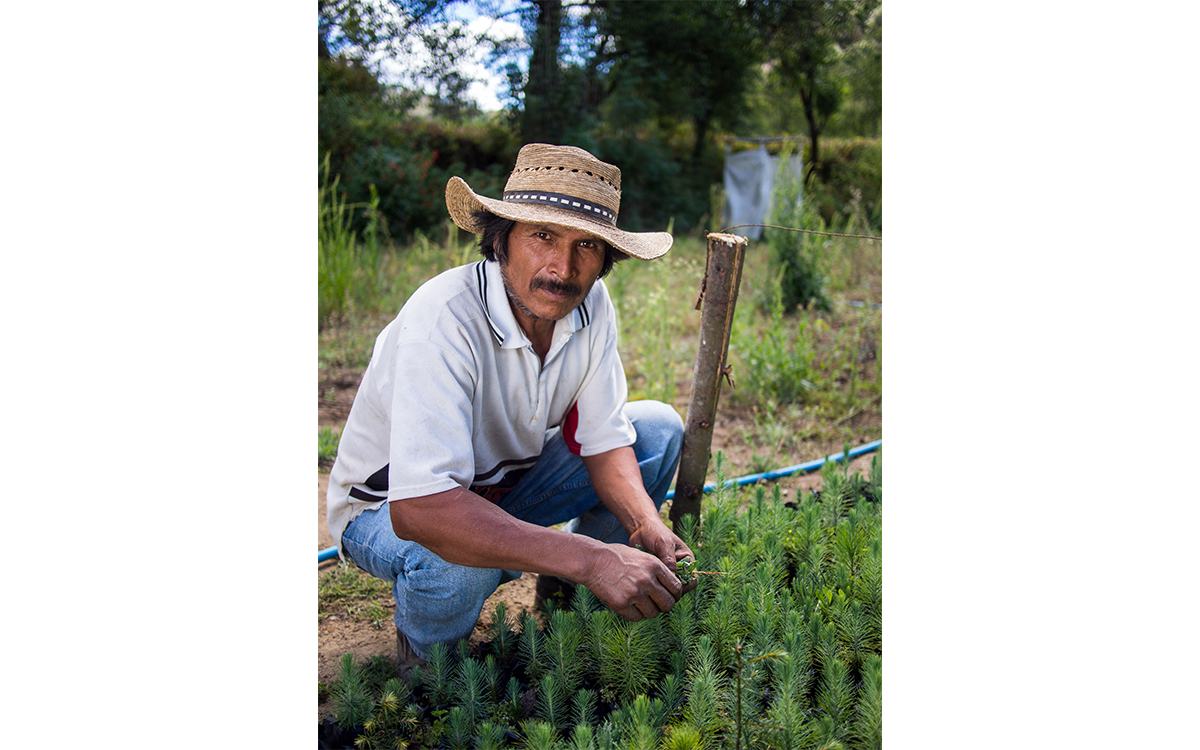Butterflies’ Greatest Advocates
New documentary shows how far one community goes to protect monarchs

Photos courtesy of Eidolon Films
Residents of the rural Indigenous Mexican farming community of Donaciano Ojeda have made it their mission to protect their local forest from logging—and in so doing, to guard the monarch butterflies that land there each fall following their epic journeys through the U.S. and Canada. Members of the community patrol their forest in 24-hour shifts, watching to be sure their trees are safe. Tessa Moran and Ben Crosbie, a wife-and-husband documentary filmmaking team from Washington, D.C., spent three years laboring to tell the story of Donaciano Ojeda through the lenses of two men, Santos and Aristeo, who are vocal advocates for the monarchs—and for the water supply that also depends on their fiercely guarded forest. Moran’s and Crosbie’s resulting documentary, The Guardians, produced by Eidolon Films, premieres tomorrow, October 28 on PBS, at 10 PM ET; it can also be streamed October 29 through November 8. Sierra connected with the filmmakers to learn about their process, their unique relationships with the people of Donaciano Ojeda, and what this community’s fierce commitment can teach us all about conservation.

Sierra: What led you to this particular topic and community?
Moran: We were on a cross-country flight, a United Flight. We picked up the in-flight magazine, and there was an article about the plight of monarch butterflies, about how millions of monarchs migrate from Canada, across the United States to Mexico each year in dwindling numbers. But they land in this one part of Mexico. The article talked about the general plight of the monarchs but also the conservation efforts of communities in Canada, the United States, and Mexico, including a group of farmers who would patrol the forest where the monarchs migrate to and hibernate, in 24-hour shifts, seven days a week. There was an image of men warming tortillas by a fire overnight that struck us as particularly cinematic.
We wanted to explore more off this relationship between human and nature. That’s what brought us to Mexico on our first trip. We didn’t really know what we were going to get into or what the story would turn out to be, but we reached out to a nonprofit that brokered an initial meeting with leaders of the community who met us in a town square and asked us a bunch of questions. Eventually they gave us access to the community. And that access was something that we built over years that we filmed, over a series of trips.
The high level of intimacy with the subject is clear to the viewer. How did you nurture these relationships with the families of Donaciano Ojeda?
 Crosbie: The two sort of main characters of the film, they jumped out really early on, during our first trip. We visited a small tree nursery on our first day, and Aristeo, who sort of manages that, was right away very open and willing to talk to us. And while we were there, Santos, who lives very close, must have seen what was going on. He wandered down and introduced himself. Both of them were just really open. That was the first entry point to getting to know them. We had other characters we met on that first trip, who ended up not being part of the film for various reasons, but, throughout our trips, these two characters stayed in contact with us and allowed us to come back each time.
Crosbie: The two sort of main characters of the film, they jumped out really early on, during our first trip. We visited a small tree nursery on our first day, and Aristeo, who sort of manages that, was right away very open and willing to talk to us. And while we were there, Santos, who lives very close, must have seen what was going on. He wandered down and introduced himself. Both of them were just really open. That was the first entry point to getting to know them. We had other characters we met on that first trip, who ended up not being part of the film for various reasons, but, throughout our trips, these two characters stayed in contact with us and allowed us to come back each time.
Each time we went back—it ended up being six total trips over two years—they gave us more access to their families. As they got to know us as people, they got to know that we kept coming back every few months; we weren’t just flying in once to grab something and never coming back. That was a piece of it.They saw that we were committed to coming over and over again to tell the longer, bigger-picture story, not just grabbing some really quick sound byte and never coming back.
Moran: We got this great advice about some of the challenges that we were facing, as people who were outsiders, for outsiders of any community. This producer said, ‘You want to be part of the community, look around and see what the community does and go and do that.’ That involved putting down the camera and helping out in the field some days for eight hours without filming anything—just picking corn, planting trees, just as any family member or community member would do. That demonstrated to the community that we were there not just as filmmakers but as community members for that period of time.
There are always challenges, as a filmmaker, journalist, or ethnographer, of getting a story without putting undue pressure on the community, and while respecting reciprocity. Did you do anything to thank the community for the opportunity to make the movie?
 Crosbie: Throughout the process, people would ask us those very questions: ‘Why are you here? Other people like you have come here before and taken from us without giving anything back. Why should we trust you? Why should we speak to you, why should we allow you here?’ Our point of view as the filmmakers is that we came in thinking this was an interesting story and we wanted to get the most authentic version of what their community was doing. It helped that the two main characters shared our perspective and felt that sharing their story was important for others to hear. The community leaders felt very similarly, that they were doing a lot of work in the community on conservation that benefits them and their environment. And they saw the potential for this film—of showing the challenges and successes that they go through—and thought that if other people saw that, potentially, something good might come of it.
Crosbie: Throughout the process, people would ask us those very questions: ‘Why are you here? Other people like you have come here before and taken from us without giving anything back. Why should we trust you? Why should we speak to you, why should we allow you here?’ Our point of view as the filmmakers is that we came in thinking this was an interesting story and we wanted to get the most authentic version of what their community was doing. It helped that the two main characters shared our perspective and felt that sharing their story was important for others to hear. The community leaders felt very similarly, that they were doing a lot of work in the community on conservation that benefits them and their environment. And they saw the potential for this film—of showing the challenges and successes that they go through—and thought that if other people saw that, potentially, something good might come of it.
Moran: It was important that they would not be ignored, and that not just people in the United States understood the efforts they were making on behalf of monarchs—which, as you know, migrate across the U.S. and Canada and are not just Mexico’s problem, but our problem too—but also they wanted others in Mexico to see what they were doing. The efforts they were making were critical not just for the monarchs, but for the water supply. They were helping to provide a clean water supply for all of Mexico City. A lot of their commitment to the project came from that understanding, that their story was important to preserve.
We returned to the community to show it to the characters and the community before it was shown to anyone else. They also received DVDs to keep as an archive and a record. It was an interesting dynamic, because of course we can’t pay our subjects in order to maintain the integrity of the story, so these issues are difficult to navigate. Now that we have started releasing the film, people have asked how they can help the community. The most direct way is through organizations in the U.S. and Mexico that fund communities like Ojeda. I say, ‘You like the story? Here’s how you can contribute.’
Can you talk about portraying the community’s unique leadership and mechanisms of democracy? Most of the community’s conservation decisions seem to be based upon the consensus model practiced in town hall meetings.
Crosbie: Yeah, those town council meetings were really interesting, and they were something we wanted to get into from the beginning of filming. It took a few trips to get access to them because as you saw, that is where they make a lot of big decisions. It was interesting to see so many people being able to share their opinion. It seems like this great way to make decisions. But then you also see people complaining about things that they have clearly talked about for years and haven’t had conflict resolution.
Moran: The way that they operate is slow, because they need to have full buy-in from everyone. At first, I thought, How is that even possible? But it becomes possible over time. Once they get buy-in from everyone, which is a really slow process, the commitment is that much stronger to their conservation efforts. They are able to get everyone to participate because it is an entrenched community belief system, not just a decision that was made.
I will note that the way that land ownership works in these communities is that land is handed down from a man to his son, not his daughters. So you will see significantly more men than women in those meetings. There is one woman who speaks up in one of those meetings, because she is a landowner, because she is a widow. Women can become landowners only if their husbands die. They retain their land until it is handed down to their sons. So that is a big part of the community isn’t equal.
Did any members of this Indigenous community ever mention Indigenous belief systems in expressing their desire to do this work? Or was it simply that, as farmers, they felt that they had to do this to protect their water source?
Moran: Absolutely, it was very clear that this was inherent to their culture, their belief systems, their identity, to have a strong forest and strong trees for their survival. Mexico is unique in that Indigenous people still have a great degree of land rights. We see them at the helm of decision-making in their own land, which is maybe not what you see in other parts of the world.
Crosbie: Their beliefs seemed to be tied to getting back to a place of what their parents’ and grandparents’ environment was like, rather than a deeper cultural belief.
Did conservation efforts feel different in this rural Mexican context, compared to how it’s packaged in the U.S.?
Crosbie: We’ve met a lot of people in the U.S. in the conservation and monarch space,who are deeply passionate about doing this work, and have dedicated their lives to it. But in Mexico it felt--I wouldn’t say like an obligation—but like they just recognized that they had to do this to survive. This is a daily survival mechanism for them. It wasn’t something that they had a deep intellectual discussion about to get to that point. They just realized, if we don’t do this, we are going to be in trouble in ten years.
The challenge we face in America, over and over again, is that it is really hard to tell people that if they don’t do something, they are going to be in trouble. In this community they really understood that, right up front. Maybe it is because they live so much in nature. In America most of us live in cities, and are detached from the environment around us. In this community, if one year something goes wrong, the next year they may not have water and can’t grow crops.
Moran: The stakes are higher. We all know this in the conservation space, that those who do the least to contribute to climate change are the ones that are affected the most. Front-line protectors, like many Indigenous communities—their stakes are more immediate.
Also, we tend to think that conservationists have to be highly educated, have to have doctoral degrees. And I am not saying that the science isn’t critically important, but there are leadership opportunities even for people who are illiterate, like a lot of people in Ojeda. It was important to us to show that while the monarch movement might have luminaries—PhDs and doctors explaining why it is important to conserve habitat— we wanted the story to come from these people, a voice we haven’t heard before.
 The Magazine of The Sierra Club
The Magazine of The Sierra Club



